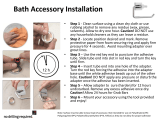8
away from moving parts.
Loose clothes, jewel-
lery or long hair can be caught in moving parts.
g.
If devices are provided for the connection of
dust extraction and collection facilities, ensure
these are connected and properly used.
Use of
dust collection can reduce dust-related hazards.
h.
Do not let familiarity gained from freuquent use
of tools allow you to become complacent and ig-
nore, tool safety principles.
A careless action
can cause severe injury within a fraction of a sec-
ond.
4 POWER TOOL USE AND CARE
a.
Do not force the power tool. Use the correct
power tool for your application.
The correct
power tool will do the job better and safer at the
rate for which it was designed.
b.
Do not use the power tool if the switch does not
turn it on and off.
Any power tool that cannot be
controlled with the switch is dangerous and must
be repaired.
c.
Disconnect the plug from the power source and/
or battery pack from the power tool before
making any adjustments, changing accessories,
or storing power tools.
Such preventive safety
measures reduce the risk of starting the power
tool accidentally.
d.
Store idle power tools out of the reach of chil-
dren and do not allow persons unfamiliar with
the power tool or these instructions to operate
the power tool.
Power tools are dangerous in the
hands of untrained users.
e.
Maintain power tools. Check for misalignment
or binding of moving parts, breakage of parts
and any other condition that may affect the pow-
er tool‘s operation. If damaged, have the power
tool repaired before use.
Many accidents are
caused by poorly maintained power tools.
f.
Keep cutting tools sharp and clean.
Properly
maintained cutting tools with sharp cutting edges
are less likely to bind and are easier to control.
g.
Use the power tool, accessories and tool bits
etc. in accordance with these instructions tak-
ing into account the working conditions and the
work to be performed.
Use of the power tool for
operations different from those intended could
result in a hazardous situation.
h.
Keep handles dry, clean and free from oil and
grease.
Slippery handles do not allow for safe
handling and control of the tool in unexpected
situations.
5 SERVICE
a.
Have your power tool serviced by a qualified re-
pair person using only identical replacement
parts.
This will ensure that the safety of the pow-
er tool is maintained.
Machine-related safety instructions
–
Always hold the machine by the insulated han-
dles because the heating unit and adhesive noz-
zle can become very hot. Risk of burns!
–
Always use the machine in well-ventilated
rooms.
Otherwise there is a risk that excessive
quantities of vapour will develop during work.
–
Do not use the machine for overhead work.
When performing overhead work, there is a dan-
ger of hot liquid adhesive dripping on the ma-
chine operator.
–
Protect the machine from moisture.
Moisture
can cause electric shocks.
–
Protect the cable from heat sources, oil and
sharp edges and keep away from hot machine
components.
Damage to the cable can cause
electric shocks.
–
Check the plug and the cable regularly to avoid
hazards and have them replaced by an autho-
rised after-sales service workshop if they be-
come damaged.
A defective plug or cable can
cause electric shocks.
–
Do not pull the plug from the socket by the ca-
ble.
The plug or cable may become damaged and
cause electric shocks.
–
Always use an extension cable with protective
earth conductor.
If an extension cable is used
without a protective earth conductor, the ma-
chine's electrical system is no longer protected,
which can cause electric shocks.
–
CAUTION!
To provide continued protection
against risk of electric shock, connect to prop-
erly grounded outlets only.
–
Always remove melted adhesive cartridges by
purging.
Adhesive cartridges that are not melted
can be removed by hand.
–
CAUTION!
Clean the system no more than six
hours after using PU adhesive.
If instructions in
the operating manual or other documents ac-
companying individual machines relating to the
connection, installation, commissioning, opera-
tion, use and maintenance of machines are not
followed, any claim to warranty will be lost.
–
Wear suitable personal protective equipment:
dust mask for reducing the risk of inhaling haz-
ardous vapours, protective gloves for handling
hot machine components, safety goggles.
–
The Festool edge bander should always be
mounted on work benches using the stationary

















